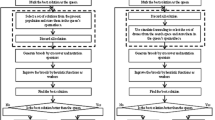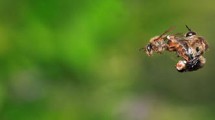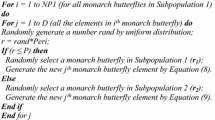Abstract
Over the last decade, evolutionary and meta-heuristic algorithms have been extensively used as search and optimization tools in various problem domains, including science, commerce, and engineering. Their broad applicability, ease of use, and global perspective may be considered as the primary reason for their success. The honey-bees mating process may also be considered as a typical swarm-based approach to optimization, in which the search algorithm is inspired by the process of real honey-bees mating. In this paper, the honey-bees mating optimization algorithm (HBMO) is presented and tested with few benchmark examples consisting of highly non-linear constrained and/or unconstrained real-valued mathematical models. The performance of the algorithm is quite comparable with the results of the well-developed genetic algorithm. The HBMO algorithm is also applied to the operation of a single reservoir with 60 periods with the objective of minimizing the total square deviation from target demands. Results obtained are promising and compare well with the results of other well-known heuristic approaches.
Similar content being viewed by others
References
Abbaspour, K. C. and Schulin, R., and van Genuchten, M. T., 2001, ‘Estimating unsaturated soil hydraulic parameters using ant colony optimization’, Adv. Water Resour. 24(8), 827–933.
Abbass, H. A., 2001a, ‘Marriage in honeybees optimization (MBO): A haplometrosis polygynous swarming approach’, in The Congress on Evolutionary Computation, CEC2001, Seoul, Korea, May 2001, pp. 207–214.
Abbass, H. A., 2001b, ‘A monogenous MBO approach to satisfiability, in The International Conference on Computational Intelligence for Modelling’, Control and Automation, CIMCA'2001, Las Vegas, NV, USA.
Brasil, L. M., de Azevdo, F. M., Barreto, J. M., and Noirhomme, M., 1998, ‘Training algorithm for Neuro-Fuzzy-GA systems’, in Proc. 16th IASTED International Conference on Applied Informatics, AI'98, Garmisch-Partenkirchen, Germany, pp. 45–47.
Dietz, A., 1986, ‘Evolution’, in T. E. Rinderer (ed.), Bee Genetics and Breeding, Academic Press Inc., N.Y. pp. 3–22.
Dorigo, M., 1992, ‘Optimization, learning and natural algorithms’, Ph.D. Thesis, Politecnico di Milano, Milan, Italy.
Dorigo, M., Bonabeau, E., and Theraulaz, G., 2000, ‘Ant algorithms and stigmergy’, Future Generation Computer Systems 16, 851–871.
Dorigo, M. and Di Caro, G., 1999, ‘The ant colony optimization metaheuristic’, in D. Corne, M. Dorigo, and F. Glover (eds.), New Ideas in Optimization, McGraw-Hill, Maidenhead, London, pp. 11–32.
Dorigo, M., Maniezzo, V., and Colorni, A., 1996, The ant system: Optimization by a colony of cooperating ants, IEEE Trans. Syst. Man. Cybern. 26, 29–42.
Esat, V. and Hall, M. J., 1994, ‘Water resources system optimization using genetic algorithms’, in Hydroinformatics' 94, Proc., 1st Int. Conf. on Hydroinformatics, Balkema, Rotterdam, The Netherlands, pp. 225–231.
Gen, M. and Cheng, R., 1997, ‘Genetic Algorithm and Engineering Design’, John Wiley and Sons, N.Y.
Goldberg, D. E., Deb, K., and Horn, J., 1992, ‘Massive multimodality, deception, and genetic algorithms’, in R. Manner and B. Manderick (eds.), Parallel Problem Solving from Nature, Elsevier: Amsterdam, 2, pp. 37–46.
Jalali, M. R., Afshar, A., and Mariño, M. A., (2006). ‘Reservoir operation by ant colony optimization algorithms.’ Iranian Journal of Science and Technology, Shiraz, Iran, in press.
Jaszkiewicz, A., 2001, ‘Multiple objective metaheuristic algorithms for combinatorial optimization, Habilitation Thesis’, Poznan University of Technology, Poznan.
Laidlaw, H. H. and Page, R.E., 1986, ‘Mating designs, in T. E. Rinderer (ed.), Bee Genetics and Breeding’, Academic Press, Inc., pp. 323–341.
Moritz, R. F. A. and Southwick, E. E., 1992, Bees as Superorganisms, Springer Verlag, Berlin, Germany.
Page, R. E., 1980, ‘The evolution of multiple mating behavior by honey bee queens (Apis mellifera L.)’, Journal of Genetics 96, 263–273.
Perez-Uribe, A. and Hirsbrunner, B., 2000, ‘Learning and foraging in robot-bees, in Meyer, Berthoz, Floreano, Roitblat and Wilson (eds.)’, SAB2000 Proceedings Supplement Book, Intermit. Soc. for Adaptive Behavior, Honolulu, Hawaii, pp. 185–194.
Rinderer, T. E. and Collins, A. M., 1986, ‘Behavioral genetics, in T. E. Rinderer (ed.), Bee Genetics and Breeding’, Academic Press, Inc., pp. 155–176.
Simpson, A. R. Maier, H. R., Foong, W. K., Phang, K. Y., Seah, H. Y., and Tan, C. L., 2001, ‘Selection of parameters for ant colony optimization applied to the optimal design of water distribution systems’, in Proc., Int. Congress on Modeling and Simulation. Canberra, Australia, pp. 1931–1936.
Wardlaw, R. and Sharif, M., 1999, ‘Evaluation of genetic algorithms for optimal reservoir system operation’, J. Water Resour. Plng. and Mgmt. ASCE, 125(1), 25–33.
Author information
Authors and Affiliations
Corresponding author
Rights and permissions
About this article
Cite this article
Haddad, O.B., Afshar, A. & Mariño, M.A. Honey-Bees Mating Optimization (HBMO) Algorithm: A New Heuristic Approach for Water Resources Optimization. Water Resour Manage 20, 661–680 (2006). https://doi.org/10.1007/s11269-005-9001-3
Received:
Accepted:
Published:
Issue Date:
DOI: https://doi.org/10.1007/s11269-005-9001-3




